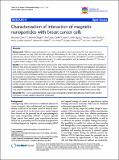Por favor, use este identificador para citar o enlazar a este item:
http://hdl.handle.net/10261/125897COMPARTIR / EXPORTAR:
 SHARE SHARE
 CORE
BASE CORE
BASE
|
|
| Visualizar otros formatos: MARC | Dublin Core | RDF | ORE | MODS | METS | DIDL | DATACITE | |

| Título: | Characterization of interaction of magnetic nanoparticles with breast cancer cells |
Autor: | Calero, Macarena; Chiappi, Michele; Lázaro-Nogal, Ana CSIC; Rodríguez, María Josefa; Chichón, Javier; Crosbie-Staunton, Kieran; Prina-Mello, Adriele; Volkov, Yuri; Villanueva, Ángeles; Carrascosa, José L. CSIC ORCID | Palabras clave: | MCF-7 cells Superparamagnetic iron oxide nanoparticles Intracellular trafficking Transmission electron microscopy Cellular uptake Endocytosis Cytotoxicity |
Fecha de publicación: | 26-feb-2015 | Editor: | BioMed Central | Citación: | Journal of Nanobiotechnology 13(1): 16 (2015) | Resumen: | [Background] Different superparamagnetic iron oxide nanoparticles have been tested for their potential use in cancer treatment, as they enter into cells with high effectiveness, do not induce cytotoxicity, and are retained for relatively long periods of time inside the cells. We have analyzed the interaction, internalization and biocompatibility of dimercaptosuccinic acid-coated superparamagnetic iron oxide nanoparticles with an average diameter of 15 nm and negative surface charge in MCF-7 breast cancer cells. [Results] Cells were incubated with dimercaptosuccinic acid-coated superparamagnetic iron oxide nanoparticles for different time intervals, ranging from 0.5 to 72 h. These nanoparticles showed efficient internalization and relatively slow clearance. Time-dependent uptake studies demonstrated the maximum accumulation of dimercaptosuccinic acid-coated superparamagnetic iron oxide nanoparticles after 24 h of incubation, and afterwards they were slowly removed from cells. Superparamagnetic iron oxide nanoparticles were internalized by energy dependent endocytosis and localized in endosomes. Transmission electron microscopy studies showed macropinocytosis uptake and clathrin-mediated internalization depending on the nanoparticles aggregate size. MCF-7 cells accumulated these nanoparticles without any significant effect on cell morphology, cytoskeleton organization, cell cycle distribution, reactive oxygen species generation and cell viability, showing a similar behavior to untreated control cells. [Conclusions] All these findings indicate that dimercaptosuccinic acid-coated superparamagnetic iron oxide nanoparticles have excellent properties in terms of efficiency and biocompatibility for application to target breast cancer cells. |
Versión del editor: | http://dx.doi.org/10.1186/s12951-015-0073-9 | URI: | http://hdl.handle.net/10261/125897 | DOI: | 10.1186/s12951-015-0073-9 | ISSN: | 1477-3155 |
| Aparece en las colecciones: | (CNB) Artículos |
Ficheros en este ítem:
| Fichero | Descripción | Tamaño | Formato | |
|---|---|---|---|---|
| 12951_2015_Article_73.pdf | 2,46 MB | Adobe PDF |  Visualizar/Abrir |
CORE Recommender
PubMed Central
Citations
41
checked on 10-abr-2024
SCOPUSTM
Citations
97
checked on 19-abr-2024
WEB OF SCIENCETM
Citations
100
checked on 28-feb-2024
Page view(s)
303
checked on 23-abr-2024
Download(s)
385
checked on 23-abr-2024

